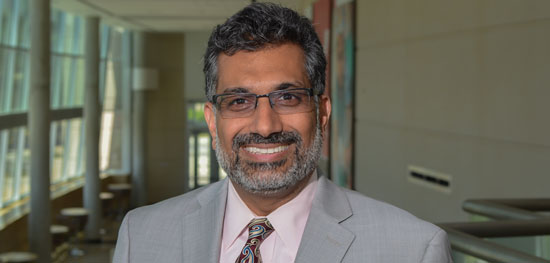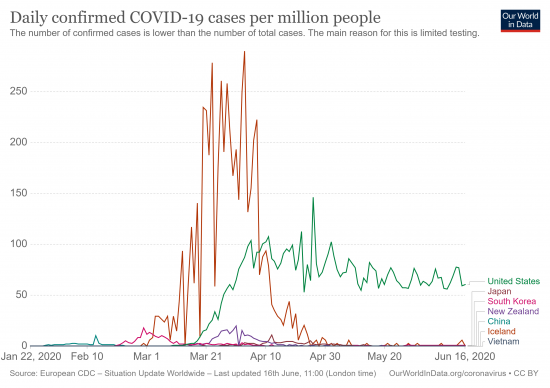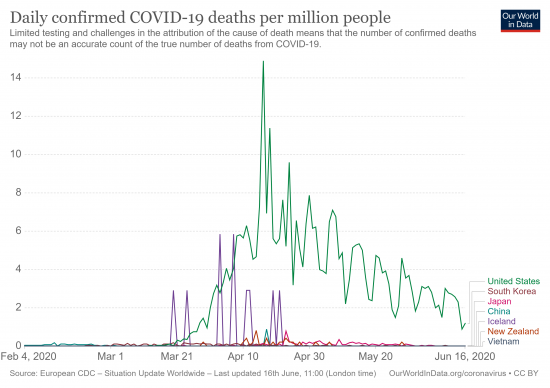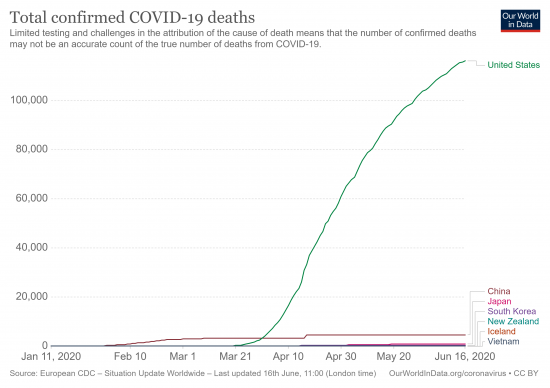
For years, I served as a disease detective at the Centers for Disease Control and Prevention. Our team identified and stopped infectious diseases – monkeypox, Ebola and, yes, SARS – before they become pandemics.
From my time as a disease detective, I've seen how pandemics end. An ounce of COVID-19 prevention is worth a pound of COVID-19 cure. And with no vaccine available today, prevention is the best way to protect a community from COVID-19.
Different approaches yield different outcomes
Scientists measure the rate of how quickly a virus spreads by its reproductive number (R0). For SARS-COV-2 – the coronavirus that causes COVID-19 – the estimated reproductive number is two. So one person with COVID-19 spreads it to two more. Those two new cases spread it to two more people each, which means four additional COVID-19 cases. And so on.
So why does COVID-19 seem to spread so differently in different areas? Why have some countries contained the virus, while others continue to see their case numbers rise?
If you look at the public health strategy of various countries in the initial phase of this outbreak from Asia, Oceania, and Europe, it's clear that different approaches have affected the spread of COVID-19.
China. China initially had the most number of cases and an alarmingly high spread. Now things are much better. The city of Wuhan, where the virus was first detected, tested 9.9 million people in 19 days at the end of May. They found just 300 positive cases, all without symptoms.
Iceland. Only 0.56% of COVID-19 cases become fatal in Iceland – a shockingly low number. A team of health experts checks on COVID-19 patients with underlying conditions every day and otherwise young, healthy COVID-19 patients twice a week. A team of nurses and doctors call confirmed patients to ask, "How are you doing? What are your symptoms? Are you getting all the help you need?"
Japan. Despite low testing, Japan got their outbreak under control by good, old-fashioned public health practices: boots on the ground contact tracing.
New Zealand. The government mandated a countrywide lockdown from March 25 to April 27. Nobody could leave home except for outdoor exercise. As of this writing, New Zealand using a public health strategy has announced elimination of COVID and is fully opening up their society.
South Korea. At the end of February, South Korea had the second highest number of COVID-19 cases in the world (China was first). Then South Korea quickly implemented fast, free COVID-19 tests and aggressive contact tracing. South Korea tested 145,000 people by March 5, which was more than the United States, the United Kingdom, Japan, Italy and France combined. In a country of 51 million, 273 lives have been lost to COVID-19.
United States. About 20,000 new cases are reported daily – sometimes much more. Every 20,000 new cases turns into around 200 new deaths two weeks later. Every state has a different plan, with a severe lack of contact tracing. Currently, over 109,000 people have lost their lives to COVID-19.
Vietnam. Over 97 million people live in Vietnam, which shares a border with China. Today, Vietnam has also achieved elimination with zero deaths, less than 500 cases and no domestic transmission for 51 days.
Compare the COVID-19 outbreak by the numbers
Below are two graphs depicting daily confirmed cases (per million) and daily deaths (per million) for the seven countries we just looked at. Most are trending downward. Some curves are difficult to even see. The green line representing the United States is apparent on both graphs – especially at the right edge of the graph showing most recent data, as of this writing.


Can social distancing end this pandemic?
There's no doubt, social distancing stops infectious diseases. The whole point of social distancing is to slow the spread of COVID-19. Over 90% of the spread of COVID-19 is from an infected person talking, sneezing or coughing. These actions send respiratory droplets (containing the coronavirus) into the surroundings, which can infect others. The less contact you have with others, the less likely you are to spread COVID-19.
Some workplaces (like hospitals) can't close, even in the midst of a pandemic. These people must still go out in public with other humans and do their jobs. That's why social distancing is only one part of the puzzle. Pandemics end because of a shared responsibility between individuals and their government.
- We as individuals have a responsibility: We try not to get infected. We also try not to infect others
- The government also has a responsibility to provide testing, contact tracing and public health information
If we continue to see so many new COVID-19 cases daily, something isn't working. The high number of new cases we see in Nebraska every day is abnormal, and it's a higher rate than some entire countries are experiencing.
Will Husker football return in the fall?
Some are wondering whether we'll experience a second wave in the fall. We're not even through the first wave yet.
Over the past two months, Nebraska has averaged about 250 cases a day. This has been declining to 100 cases a day, which is still very high.
Whether you can go to a football game at Memorial Stadium depends not just on you and me. Whether your kids go back to school in the fall depends not just on you and me. We will wear masks, social distance and wash our hands. But only our elected officials can interrupt community transmission and make it truly safe to see the Huskers go to a bowl game this year!
Nebraska is 10th in the nation per capita for COVID-19 cases.
You might ask local elected officials why that is. Our high number of cases is the biggest factor preventing life from resuming to a better normal.
We all want to return to family reunions, weddings, funerals, concerts, movies, school and sports. But look at the numbers to see how quickly COVID-19 is spreading. Douglas County is averaging 100 new positive cases every day.
As of this writing, Nebraska has had 16,860 confirmed positive cases of COVID-19. We've experienced 226 deaths.
See the graph below for the total number of confirmed COVID-19 deaths in the United States. This will likely be the third leading cause of death in America this year after only heart disease and cancer.
This pandemic will end eventually. The only question is how long we are willing to let it go on.





